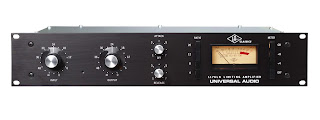Hello and welcome to this week's article!
Today we are talking about a very interesting tool to compress or limit a sound (under this point of view this article goes under the main category of COMPRESSORS) slighly different from the compressors and limiters interface of today.
In the old times (we are talking of the '60s), gain reduction was not a trend as today: sounds were much less "in your face", recordings were less loud and there was a lot of headroom and dynamic range (on the other hand songs were much less powerful and many nuances were hard to hear because they were really low in volume).
In the early '60s a producer called Teletronix created one of the most famous compressors of the time, the LA-2A Leveling Amplifier, a tube-driven peak limiter which still today is used by some classic studio due to its simplicity and the very particular harmonic enhancement produced.
In 1968, then, a producer called Urei created a peak limiter that still today is considered by many studios a standard, and it is still in production: the 1176Ln Peak Limiter, one of the first compressors / peak limiters (at the time the concept of compressor and limiter was really the same) to be completely solid state, unlike the other models which all were tube-driven.
In the modern times Compressors and Limiters have taken different roads, specializing in different tasks and different phases of the music production, but the origin of both is the Peak Limiter, a tool that originally had just two knobs: Peak Reduction and Gain (or Input and Output).
Peak reduction controls the amount of compression to apply to the signal (as can be seen also from the VU meter), Gain controls the output volume. That's it.
Obviously with the following releases of the 1176, the unit started having more and more controls, to the point that today is very similar to a modern compressor: you can choose the compression ratio among four modes (or press all the buttons together to drive the ratio to the max), you can decide attack and release with two knobs and there are different ways of using the VU Meter.
HOW TO USE TODAY A PEAK LIMITER:
Mixing: There are many uses of a compressor (both physical or one of the countless VST versions, such as the freeware Modern Lost Angel or Modern Seventh Sign by Antress, or the Variety of Sound Thrillseeker, or Nomad Factory Bus Driver), but today this kind of units are used mainly for Buss Compression.
A typical use of a Peak Limiter is on the Drum Overhead Buss: usually the snare is the loudest drum part picked up by the oh microphones, therefore putting a peak limiter in the OH buss lets us compress the snare sound and raise and make stable the level of the cymbals: this way the cymbals will be more audible and with less dynamic range, and at the same time the snare will pop out less but it will gain in weight and sustain.
The only thing to remember is to balance the output of the signal, because since we are adding db of gain IN, we should lower accordingly of the same amount of db the OUTPUT in order to leave the overall level of the track unaltered, just processed.
The only thing to remember is to balance the output of the signal, because since we are adding db of gain IN, we should lower accordingly of the same amount of db the OUTPUT in order to leave the overall level of the track unaltered, just processed.
A peak limiter is also good on single tracks such as Bass or Vocals, adding weight and loudness, if we want to use compression as a tone shaping tool, since this obviously is not the most transparent way of processing our track.
One last great way to use a peak limiter is for parallel compression: this way we can really squeeze a buss with all the drum parts, and then mix this sound back into the unprocessed sound, until we find the desired mix between the two.
Mastering: There are some mastering engineers who prefers the subtlety of a multiband compressor in the mastering buss, in order to be able to tame selectively certain frequences and to make adjustments even in the mastering phase, and some other engineers who prefer to have all the mix equilibrium perfect, and then slam the track with a broadband compressor, leveling equally all frequences (I often prefer this solution, and if there is some frequency that needs to be tamed, I prefer going back to the mixing project and solve the problem from there). With the hardware version obviously the hardware needs to be stereo, otherwise two units are needed, anyway this kind of peak limiter is very good in mastering, because often the harmonic excitement and the warmth that it adds to the song is just what it takes to bring a recording to the next level.
Become fan of this blog on Facebook! Share it and contact us to collaborate!!


No comments:
Post a Comment